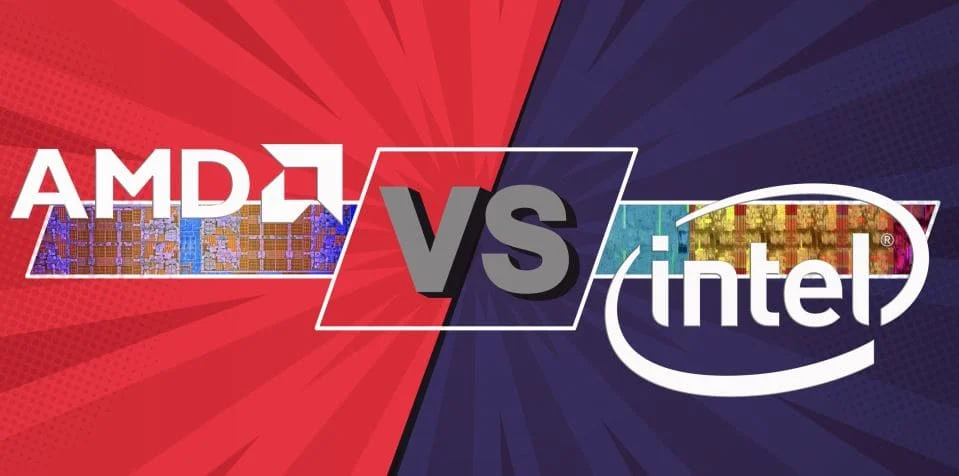Blogs
Difference between AMD and Intel processors: Which Processor is Best for You?

In this blog we highlight the competition between Intel and AMD in the CPU market. This benefits consumers by giving them better quality processors at lower price, resulting in more affordable, high-performance CPUs.
The central question posed is: “Among the best CPUs available, which one should you buy?”
Also read – Which Laptop is Best, New or Second Hand?
A Brief Overview of AMD and Intel in 2025
AMD has solidified its position with the Ryzen 7000 and 8000 series, which feature the high end X3D chips designed specifically for gaming. The CPUs deliver exceptional multi core performance, massive caches and power efficiency through the implementation of cutting edge 4 nm and 3D V-Cache technology.
Intel, though, continues to impress with Core 13th and 14th Gen processors, as well as the new Core Ultra 200S chips. Intel processors stand out in single-thread performance, which is best for tasks that require high clock speeds, such as some games and pro software. The P-core and E-core hybrid architecture offers flexibility but at times may be a step away from achieving maximum efficiency with some software optimization.
What is single-thread performance?
Single-thread performance is the speed at which a CPU core can process tasks with a single processing thread. Most common applications and older games are dependent on a single thread more than distributing the load across multiple cores. A CPU with good single-thread performance can process instructions at higher clock rates and with less latency, leading to smoother performance in applications such as gaming, design software and some productivity applications..
What is P-core and E-core hybrid architecture?
The P-core and E-core hybrid architecture is Intel’s design that combines two types of CPU cores in one chip.
- P-cores (Performance cores): These are high-power cores built for heavy tasks like gaming, video editing or running demanding software. They focus on maximum speed and performance.
- E-cores (Efficiency cores): These are smaller, energy-efficient cores designed to handle background tasks, multitasking and lighter workloads without using much power.
By mixing P-cores and E-cores, Intel CPUs can balance performance and efficiency—running big jobs on P-cores while leaving everyday tasks to E-cores. This makes the system faster and more power-efficient, though some software still needs optimization to use both core types effectively.
Gaming Performance: AMD Steals the Show
In gaming, AMD’s Ryzen 7000 X3D series processors (e.g.,Ryzen 7 5800X3D and Ryzen 9 5900X3D) featuring 3D V-Cache technology currently hold the title for fastest gaming CPUs.
- These processors deliver particularly strong performance in games that benefit from increased cache size, often surpassing Intel’s high-end offerings in most gaming scenarios.
- Therefore, AMD’s X3D chips are top choices for high-end gaming builds.
- Despite this, the Intel Core i9-14900K remains an extremely strong competitor across most categories.
Intel’s Core i9-14900K and i7-14700K are still great for single-threaded games. However, the combination of multi-core capabilities along with high cache renders AMD ideal for high-resolution gaming as well as esports gaming.
Content Generation and Productivity: Multi-Core versus Single-Core
- Intel CPUs typically excel in single-threaded applications such as photo editing, basic video editing, and routine productivity, due to higher clock speeds and superior single-core performance.
- AMD CPUs perform better in multi-threaded workloads like video rendering, 3D modeling, and content creation, benefiting from more cores and efficient multi-threading.
AMD Socket Longevity and Integrated Graphics
– AMD is praised by the tech geeks for maintaining the same CPU socket (AM4) across multiple generations, this enables the users to upgrade CPUs (e.g., from first to third-generation Ryzen) with only a BIOS update, and thus avoiding costly motherboard replacements.
– This approach minimizes upgrade costs and make it simple to keep systems updated.
– AMD’s Ryzen APUs come with integrated graphics, making them ideal for budget builds or users who plan to upgrade GPUs later.
Intel's Technological Innovations and Socket Changes
- Intel frequently introduces architectural changes and new tech such as support for PCIe 4.0, this gives them a following among users seeking higher performance.
- Therefore, Intel tends to change sockets more often, which require motherboard upgrades when upgrading CPUs.
- This increases costs and complicate upgrades, thus AMD leads in long-term upgradeability and cost efficiency.
Power Efficiency and Heat Management
- Power consumption depends on factors like lithography and architecture; higher power typically means more heat and stronger cooling requirements.
- Intel has improved power efficiency from higher levels (due to its 14nm process) to a more reasonable state with the Intel 7 process and x86 hybrid architecture in recent generations (notably Raptor Lake).
- Despite improvements, Intel CPUs consume more power than AMD Ryzen processors.
- AMD’s 5nm chips offer either lower power usage or better power-to-performance ratios, allowing more work per watt and requiring less demanding cooling.
- Conclusion: AMD is the winner in power efficiency and cooling requirements.
CPU Overclocking Capabilities
- Intel CPUs, especially the K-series chips, provide more overclocking headroom and allow users to push clock speeds to 6.0–6.2 GHz on 13th gen Raptor Lake processors.
- Overclocking Intel requires investing in a premium Z-series motherboard and paying a price premium for unlocked CPUs.
- AMD Ryzen CPUs have limited manual tuning options and generally achieve lower all-core overclocks (several hundred MHz below peak single-core boosts).
- Overclocking all cores on AMD can sometimes reduce performance in lightly threaded applications.
- Summary: Intel leads in overclocking potential and ease of achieving higher clock speeds.
Pricing and Value in 2025
Historically, AMD has been recognized for value-oriented CPUs.
Recently, Intel’s launch of Raptor Lake has sparked a fierce price battle, with Intel aggressively pricing high-performance chips to regain market share.
Both companies now offer competitive pricing and compelling performance, which is advantageous to consumers.
Summary by Price Segment:
- High-end gaming: AMD Ryzen X3D > Intel Core i9-14900K
- Mid-range performance: AMD Ryzen 7 9800X3D ≈ Intel Core i7-13700K
- Budget customers: AMD Ryzen 5 5600X3D > Intel Core i5-13400F (more multi-core value)
Security and Software Support
Intel has a mature software base and driver support, enabling certain enterprise applications to perform better. AMD’s more recent Zen 4 and 5 processors have fewer publicly known vulnerabilities and still release firmware updates to further stabilize and secure the system.
Overclocking and Tuning
For enthusiasts, overclocking can be an important consideration. Intel K-series CPUs allow more manual tuning for maximum frequency on P-cores but require Z-series motherboards. AMD’s Precision Boost and Precision Boost Overdrive provide excellent out-of-the-box performance, with minimal tweaking needed. Manual overclocking on AMD is limited but generally unnecessary due to strong default performance.
Choosing the Right CPU in 2025
Feature | AMD | Intel | Conclusion |
Socket Longevity | Long socket support (AM4) | Frequent socket changes | AMD easier for upgrades without mobo changes |
Integrated Graphics | Ryzen APUs include integrated graphics | Generally requires discrete GPU | Budget builds benefit from AMD APUs |
Technology Innovations | Stable platform, slower feature adoption | Frequent new tech (PCIe 4.0, faster RAM) | Intel leads in cutting-edge features |
Power Consumption | Lower power, better power-to-performance | Higher power draw but improving | AMD clear winner in efficiency |
Cooling Requirements | Less demanding cooling | Requires stronger cooling | Due to power usage differences |
Overclocking Headroom | Limited manual tuning | Higher overclocking potential (K-series) | Intel leads in overclocking |
Single-threaded Performance | Good but slightly behind Intel | Superior single-core speeds | Intel preferred for light-thread tasks |
Multi-threaded Performance | Strong multi-core performance | Good but often fewer cores | AMD preferred for workloads like rendering |
Gaming Performance | X3D processors lead in gaming speed | High-end models close competitor | AMD top gaming CPUs currently |
Pricing | Traditionally value-focused | Aggressive pricing with Raptor Lake | Both brands now competitive |
Final Thoughts
- AMD’s socket longevity and integrated graphics solutions offer cost-effective upgrades and budget-friendly builds.
- Intel’s latest architectures bring advanced features and better single-threaded performance but may require costly motherboard upgrades.
- AMD leads in power efficiency and cooling needs, making it better suited for energy-conscious builds.
- Intel provides more overclocking potential, particularly with premium components.
- For gaming, AMD’s Ryzen 7000 X3D processors currently outperform Intel in most scenarios.
- Pricing competition is intense, with both AMD and Intel offering aggressive deals, benefiting consumers.
- The choice depends on user priorities: AMD for gaming and upgrade flexibility, Intel for productivity and single-threaded tasks.
Also read – Best Laptop for Psychology Students in 2025: Reliable Picks for Every Budget



